
The Route
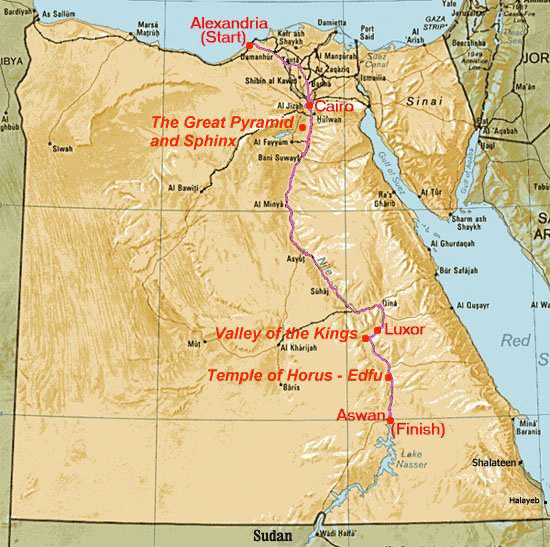
ALEXANDRIA
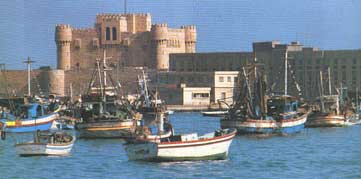
Alexandria is the second largest
city in Egypt, It has an atmosphere that is more Mediterranean than
Middle Eastern; its ambience and cultural heritage distance it from
the rest of the country although it is actually only 225 km. from Cairo.
Founded by Alexander the Great in 331 BC, who was to be buried there
just two years later, the city became the capital of the Graeco-Roman
Egypt, its status as a beacon of culture symbolized by Pharos and the
setting for the stormy relationship between Cleopatra and Mark Antony.
It is a city that has seen Alexander the Great, Cleopatra, Napoleon
and in more recent times, the famous Second World War German general
Erwin Romel, whose headquarters were turned into the city's military
museum. The city, immortalizing Alexander's name, flourished, beyond
all expectations, into a prominent cultural, intellectual and economic
metropolis, the remains of which are still evident to this day.
Click
here to learn more about the history of Alexandria
CAIRO
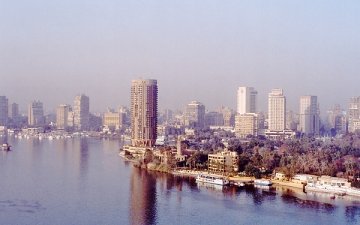
Founded
on the site of Babylon, near the ruins of ancient Memphis, Cairo has
been the largest city in Africa for centuries. Modern Cairo encompasses
many former cities and their monuments: the pyramids of the pharaohs;
early Christian monasteries and churches. Fans of Olando Bloom's 'Kingdom
of Heaven' movie should know that the famous Muslim king Salah al-Din's
citadel lies in Cairo. Five thousand years of culture are concentrated
here.
Click here to learn more
about Egypt's capital city
THE PYRAMIDS OF GIZA
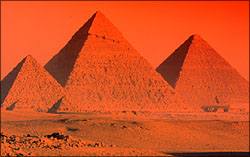
There
is an old Arab proverb 'Man fears Time, yet Time fears the Pyramids'.
You may better understand the proverb when you learn that the pyramids
were already over 2,500 years old before the birth of Christ.
Giza is the site
of the Great Pyramid, one of the Seven Wonders of the World. Towering
481 ft high over the desert, the monument took over 20 years to build.
It was built by the Egyptian pharaoh Khufu around the year 2560 BC,
to serve as a tomb when he died.
In the nearby museum
visitors can still see the mysterious Sun Boat, only discovered in 1954
near the south side of the pyramid. The boat is believed by Egyptologists
to have been used to carry the body of Khufu in his last journey on
earth before being buried inside the pyramid. According to the ancient
Egyptian religion, it may also have served him as a means of transportation
for his afterlife journey.
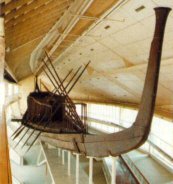
Giza is also the
home of the Sphinx. If time fears the 5,000-year-old pyramids, we can
only guess how it feels about the Sphinx, which some Egyptologists believe
could be arround 10,000 years old! Carved from a single piece of rock
73 metres long and 20 metres high, the Sphinx is a statue that has the
head of a man and the body of a lion. It's name in Arabic is Abu al-Hol,
'Father of Terror', while the ancient Greeks called it 'Sphinx' after
a mythical winged monster with a woman's head and a lion's body who
would challenge men to answer her clever riddles, killing any who failed
her tests.
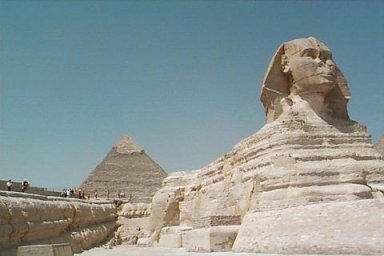
Computer
models of the Pyramids of Giza l
LUXOR
The
modern town of Luxor is the site of the famous city of Thebes, the city
of a hundred gates. It was the capital of Egypt from the 12th dynasty
(1991 BC) and reached its zenith during the New Kingdom. It was from
here that Thutmose III planned his campaigns, Akenaten first contemplated
the nature of god and Rameses II set out his ambitious building program.
Only Memphis could compare in size and wealth. Although the mud brick
palaces of Thebes have disappeared the stone built temples have survived.
The temple of Luxor
is close to the Nile and parallel with the riverbank. King Amenhotep
III who reigned 1390-53 BC built this beautiful temple and dedicated
it to Amon-Re, king of the gods.
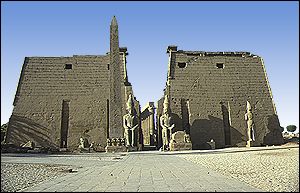
This temple has
been in almost continuous use as a place of worship right up to the
present day. It was completed by Tutankhamun and Horemheb and added
to by Ramses II. Towards the rear is a granite shrine dedicated to Alexander
the Great.
During the Christian
era the temple's hall was converted into a Christian church, and the
remains of another Coptic church can be seen to the west.
THE
VALLEY OF THE KINGS
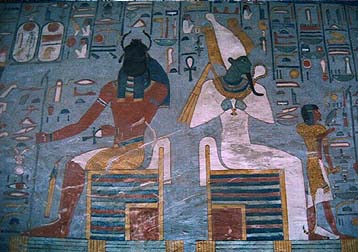
The
ancient Egyptians called this "The Place of Truth". It is
a barren desert valley far from the land of the living. Standing at
the far end of the valley is the mountain of Thebes, it creates a natural
pyramid under which the pharaohs of the 18th, 19th and 20th Dynasty
came to seek their immortality. It contains more then 60 royal tombs
from the New Kingdom. Some of Egypt's greatest rulers were buried here.
They built wonderfully decorated tombs that were cut deeply into the
valley floor and filled them with riches beyond our wildest imagination.
It
is rather ironic that the only tomb to have survived with it's treasure
almost completely intact was that of a lesser known pharaoh, a mere
boy who's deeds were probably forgotten shortly after his untimely death
and quick burial. That boy was the young King Tutankhamen. The discovery
of this tomb in 1922 by Howard Carter has dramatically changed the way
we look at Ancient Egypt.
For more then 70
years the valley has yielded nothing to compare with the magnitude of
Howard Carters discovery. Until recently that is, in 1995 Dr. Kent Weeks
decided to look once more at a tomb that had been thought to be unimportant
and in poor condition. This tomb turned out to possess a huge underground
complex, both larger and more extensive then anyone dreamed. This was
the tomb built for the 50 or more sons of Ramesses II.
EDFU AND THE TEMPLE OF HORUS
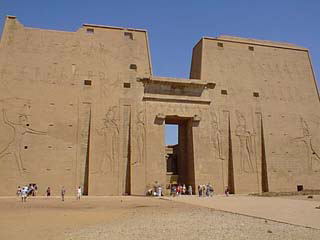 |
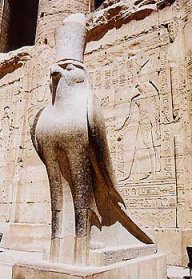 |
The temple at Edfu
is the best preserved in all Egypt, and second only to the temple at
Karnak in size.
Dedicated to Horus, the falcon headed god of wisdom and protection,
the temple was built during the reigns of six Ptolemies. It was begun
in 237 BC by Ptolemy III and was finished in 57 BC.
This
is not only one of the largest temples in Egypt, but also the best preserved.
It was believed that the temple was built on the site of the great battle
where the god Horus defeated Seth, the evil god of the desert, storm
and violence, which are all enemies of the fertile, prosperous, narrow
valley of the Nile.
ASWAN
One thousand, two hundred and thirty eight kilometres south of Alexandria lies the High Damn of the Nile and my journeys end. Aswan, Egypt's sunniest southern city and ancient frontier town, has a distinctively African atmosphere. Small enough to walk' around and graced with the most beautiful setting on the Nile.
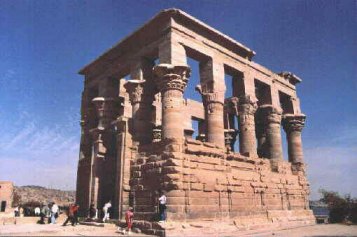
Footprints
During some of the most troublesome times in all our lives we need to be carried.
Help a child leave their tracks in the sands of time.